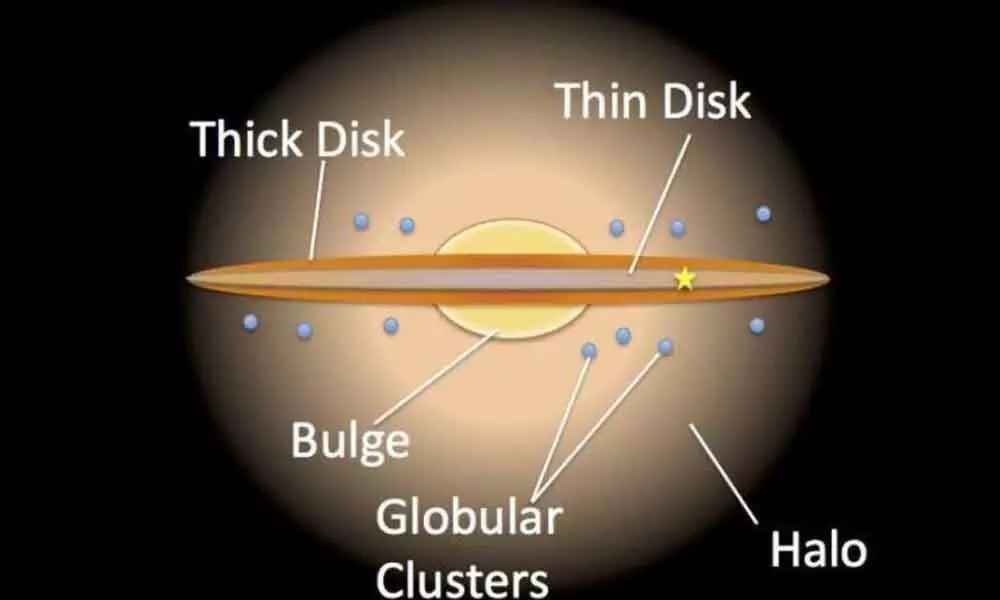Live
- Learn from fighting spirit of women bravehearts: VHP VP
- BJP MP Arvind, MLA Sanjay Kumar meet CM Revanth
- Rapido partners with L&TMRHL to provide discounted rates
- Kisan Diwas 2024: A Day Dedicated to honor our Farmers.
- Axed ACP takes the wind out of Pushpa hero’s sails
- Tender apology to CM, mantri tells Allu Arjun
- CM condemns attack on Allu Arjun’s house
- Allu Arjun’s house attacked, police arrest 6 persons in city
- APSRTC to replace diesel buses with electric buses
- Komatireddy brothers should get Oscar for lying: BRS
Just In
Star-quake vibrations lead researchers to new estimate for Milky Way age


The age of the "thick disc" of Milky Way galaxy, which contains our solar system, has remained quite a mystery but a recent discovery might help answer the long-standing question.
The age of the "thick disc" of Milky Way galaxy, which contains our solar system, has remained quite a mystery but a recent discovery might help answer the long-standing question.
Star-quakes recorded by NASA's Kepler space telescope have helped answer the mystery as the findings published in the journal Monthly Notices of the Royal Astronomical Society indicate.
A team of 38 scientists led by researchers from Australia's ARC Centre of Excellence for All Sky Astrophysics in Three Dimensions (ASTRO 3D) used data from the now-defunct probe to calculate that the disc is about 10 billion years old.
"This finding clears up a mystery. Earlier data about the age distribution of stars in the disc didn't agree with the models constructed to describe it, but no one knew where the error lay -- in the data or the models. Now we're pretty sure we've found it," said lead author Dr. Sanjib Sharma from ASTRO 3D and Australia's University of Sydney
The Milky Way -- like many other spiral galaxies -- consists of two disc-like structures, known as thick and thin. The thick disc contains only about 20 per cent of the galaxy's total stars, and, based on its vertical puffiness and composition, it is thought to be the older of the pair.
To find out how old is the disc, researchers used a method known as asteroseismology -- a way of identifying the internal structures of stars by measuring their oscillations from star-quakes.
"The quakes generate soundwaves inside the stars that make them ring, or vibrate. The frequencies produced tell us things about the stars' internal properties, including their age. It's a bit like identifying a violin as a Stradivarius by listening to the sound it makes," explained co-author Associate Professor Dennis Stello from ASTRO 3D and the University of New South Wales.
This age-dating allows researchers to essentially look back in time and discern the period in the universe's history when the Milky Way formed; a practice known as galactic archaeology.
Researchers don't actually hear the sound generated by star-quakes, but look for how the internal movement is reflected in changes to brightness.
"Stars are just spherical instruments full of gas, but their vibrations are tiny, so we have to look very carefully. The exquisite brightness measurements made by Kepler were ideal for that. The telescope was so sensitive it would have been able to detect the dimming of a car headlight as a flea walked across it," Sharma said.
The data delivered by the telescope during the four years after it was launched in 2009 presented a problem for astronomers. The information suggested there were more young stars in the thick disc than models predicted.
The question confronting scientists was stark: were the models wrong, or was the data incomplete?
In 2013, however, Kepler broke down, and NASA reprogrammed it to continue working on a reduced capacity -- a period that became known as the K2 mission. The project involved observing many different parts of the sky for 80 days at a time.
The first tranche of this data represented a rich new source for researchers from Macquarie University, Australian National University, University of New South Wales and the University of Western Australia.
They were joined in their analysis by others from institutions in the US, Germany, Austria, Italy, Denmark, Slovenia and Sweden.
A fresh spectroscopic analysis revealed that the chemical composition incorporated in the existing models for stars in the thick disc was wrong, which affected the prediction of their ages.

© 2024 Hyderabad Media House Limited/The Hans India. All rights reserved. Powered by hocalwire.com






